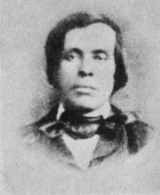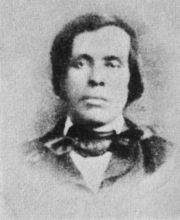
William Whipple Warren
Encyclopedia

Mixed-blood
The term mixed-blood in the United States is most often employed for individuals of mixed European and Native American ancestry who are not of Hispanic descent . Some of the most prominent in the 19th century were mixed-blood or mixed-race children born of marriages and unions between fur traders...
Ojibwe historian
Historian
A historian is a person who studies and writes about the past and is regarded as an authority on it. Historians are concerned with the continuous, methodical narrative and research of past events as relating to the human race; as well as the study of all history in time. If the individual is...
, interpreter, and legislator
Legislator
A legislator is a person who writes and passes laws, especially someone who is a member of a legislature. Legislators are usually politicians and are often elected by the people...
in the Minnesota Territory
Minnesota Territory
The Territory of Minnesota was an organized incorporated territory of the United States that existed from March 3, 1849, until May 11, 1858, when the eastern portion of the territory was admitted to the Union as the State of Minnesota.-History:...
. He moved from Wisconsin to Crow Wing
Old Crow Wing, Minnesota
Old Crow Wing is a ghost town in Fort Ripley Township, Crow Wing County, Minnesota, United States, at the confluence of the Mississippi and Crow Wing rivers. For over a century, it was the northernmost European-American settlement on the Mississippi. In the 1850s and 1860s, it was the county seat...
in the fall of 1845. Warren suffered from lung problems for many years and died as a young man of 28 from tuberculosis
Tuberculosis
Tuberculosis, MTB, or TB is a common, and in many cases lethal, infectious disease caused by various strains of mycobacteria, usually Mycobacterium tuberculosis. Tuberculosis usually attacks the lungs but can also affect other parts of the body...
on June 1, 1853.
Early life and family
William W. Warren was born at La PointeLa Pointe, Wisconsin
La Pointe is a town in Ashland County in the U.S. state of Wisconsin. The town includes all of the Apostle Islands. There is also an unincorporated community named La Pointe on Madeline Island, the largest of the Apostle Islands . The population was 246 at the 2000 census...
, Michigan Territory
Michigan Territory
The Territory of Michigan was an organized incorporated territory of the United States that existed from June 30, 1805, until January 26, 1837, when the final extent of the territory was admitted to the Union as the State of Michigan...
, on Madeline Island
Madeline Island
Madeline Island is an island of the U.S. state of Wisconsin located in Lake Superior approximately two miles northeast of Bayfield, Wisconsin, and connected to that town seasonally by a 20 minute ferry ride or an ice road. It is the largest of the Apostle Islands, although it is not included...
, the son of Lyman Marcus Warren, an American fur trader and a descendant of Richard Warren
Richard Warren
Richard Warren was a passenger on the Mayflower in 1620. He settled in Plymouth Colony and was among ten passengers of the Mayflower landing party with Myles Standish at Cape Cod on November 11, 1620...
, and Mary Cadotte, the daughter of the major fur trader Michel Cadotte
Michel Cadotte
Michel Cadotte 1764-1837 or was a Métis fur trader who dominated business in the area of the south shore of Lake Superior. He gained a strategic alliance through marriage into the Owaazsii clan of the Anishinaabeg...
, of Ojibwe-French descent, and his Anishinaabe wife Ikwesewe, of the White Crane clan. (His father's brother Truman married a sister of Mary's, so the families were doubly linked.)
After attending Protestant mission
Mission (Christian)
Christian missionary activities often involve sending individuals and groups , to foreign countries and to places in their own homeland. This has frequently involved not only evangelization , but also humanitarian work, especially among the poor and disadvantaged...
schools at La Pointe and on Mackinac Island
Mackinac Island
Mackinac Island is an island and resort area covering in land area, part of the U.S. state of Michigan. It is located in Lake Huron, at the eastern end of the Straits of Mackinac, between the state's Upper and Lower Peninsulas. The island was home to a Native American settlement before European...
, in 1836, young Warren traveled with his grandfather Lyman Warren to Clarkson, New York
Clarkson, New York
Clarkson is a town in Monroe County, New York, USA. The population was 6,736 at the 2010 census. The town is named after General Matthew Clarkson.The Town of Clarkson is on the west border of the county and is west of the City of Rochester.-History:...
. There he lived with his grandfather and attended Clarkson Academy. He then attended the Oneida Institute near Whitesboro, New York
Whitesboro, New York
Whitesboro is a village in Oneida County, New York, United States. United States. The population was 3,943 at the 2000 census. The village is named after Hugh White, an early settler.The Village of Whitesboro is inside the Town of Whitestown....
, a Presbyterian college that combined liberal and what was called industrial or crafts education. The director was Beriah Green
Beriah Green
Beriah Green, Jr. was an American reformer and noted abolitionist.Greene was born in Preston, Connecticut. He graduated from Middlebury College, Vt., in 1819, and then studied for the ministry at Andover Theological Seminary but his religious beliefs did not agree with any denominational creed.In...
, an abolitionist. In 1840 Warren returned to his family in La Pointe.
Career
Warren liked to sit with his mother's people and hear the Ojibwe stories. At age 17, he started working as an interpreter, making notes on the stories and history of the people when he could. In the fall of 1847 he moved to Crow Wing, to work for the trader Henry Mower Rice. Warren continued collecting stories and began to write a history of the Ojibwe.Soon Warren was put to work by Rice answering questionnaires on the Ojibwe sent by the geographer
Geographer
A geographer is a scholar whose area of study is geography, the study of Earth's natural environment and human society.Although geographers are historically known as people who make maps, map making is actually the field of study of cartography, a subset of geography...
and early ethnologist Henry Rowe Schoolcraft and got to meet him. This gave Warren an additional sense of how important his work was. In time away from his work as an interpreter with Rice, Warren continued to collect the stories and history he heard, as well as to figure ways to identify dates in the Ojibwe stories.
In 1851 he was a legislator with the Minnesota Territory serving in the Minnesota Terrtorial House of Representatives. Rice became a politician also, serving as an United States Senator (1858–1863) and running as a candidate for governor
Governor
A governor is a governing official, usually the executive of a non-sovereign level of government, ranking under the head of state...
in 1865.
Marriage and family
William went on to marry Mathilda Aitken, August 10, 1843 at La Pointe, Wisconsin. She was born around 1822 at Sandy Lake, MinnesotaSandy Lake, Minnesota
Sandy Lake is an unincorporated Native American village located in Turner Township, Aitkin County, Minnesota, United States. Its name in the Ojibwe language is Gaa-mitaawangaagamaag, meaning "Place of the Sandy-shored Lake"...
and baptised September 13, 1835 at La Pointe. She was the daughter of William Alexander Aitken
William Alexander Aitken
William Alexander Aitken, also known as William Alexander Aitkin , was a fur trader with the Ojibwe.-Biography:Aitken was apparently a native of Edinburgh, Scotland. He came to the Upper Mississippi region around 1802 from Canada and was employed by John Drew, a trader in the Mackinac area...
, the fur trader, and Gin-gion-cumig-oke, an Ojibwe. After the death of William Whipple Warren, Mathilda married Louis Fontaine and was allotted on the White Earth Reservation as "Mathilda Fontaine". She died October 19, 1902. Their children were:
- Alfred A. (1844–1934)
- Cordelia H. "Delia" (c. 1846–1940)
- Anna (1846–1940)
- William Tyler (1848–1900)
- Madeline (1853–1907)

